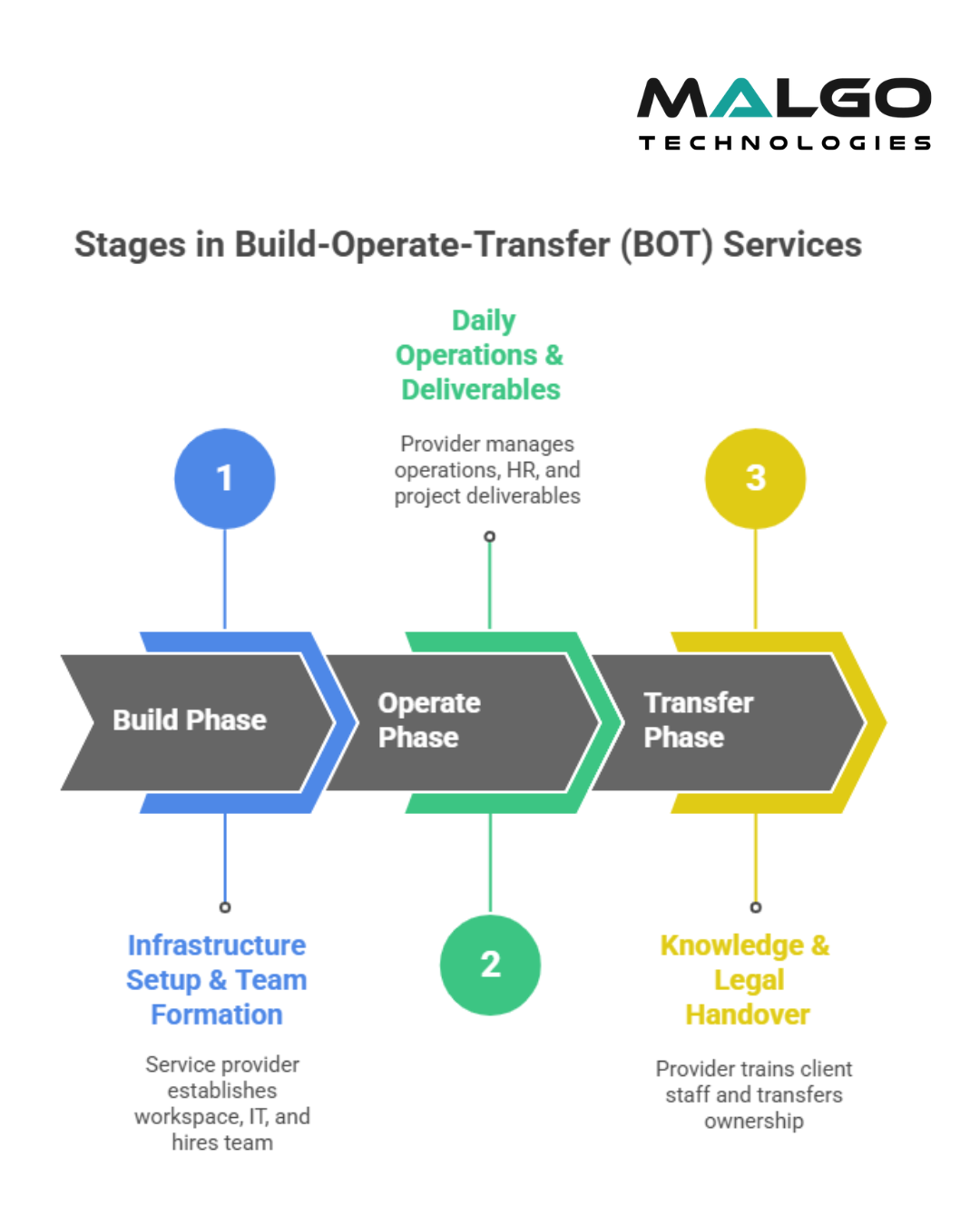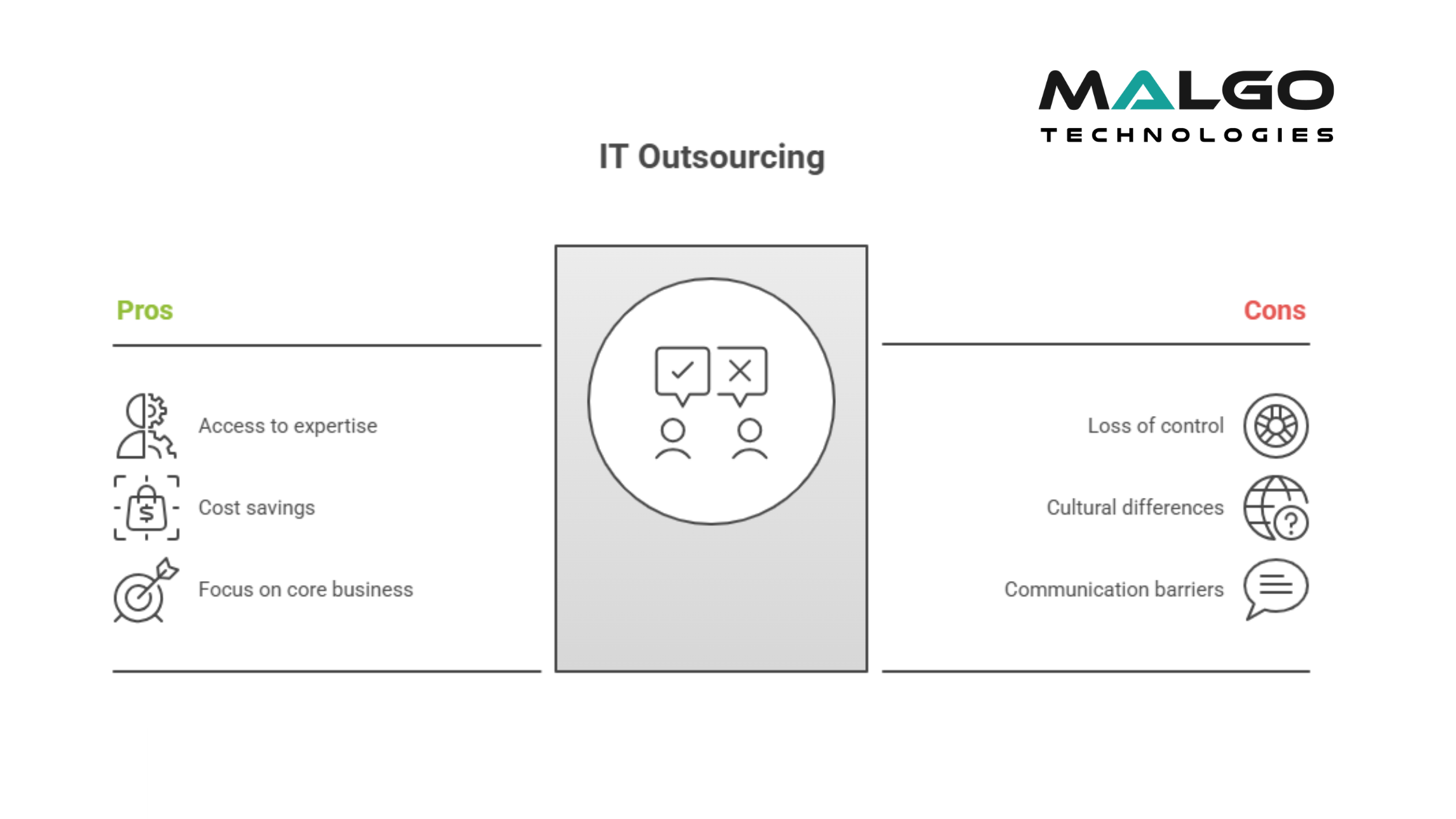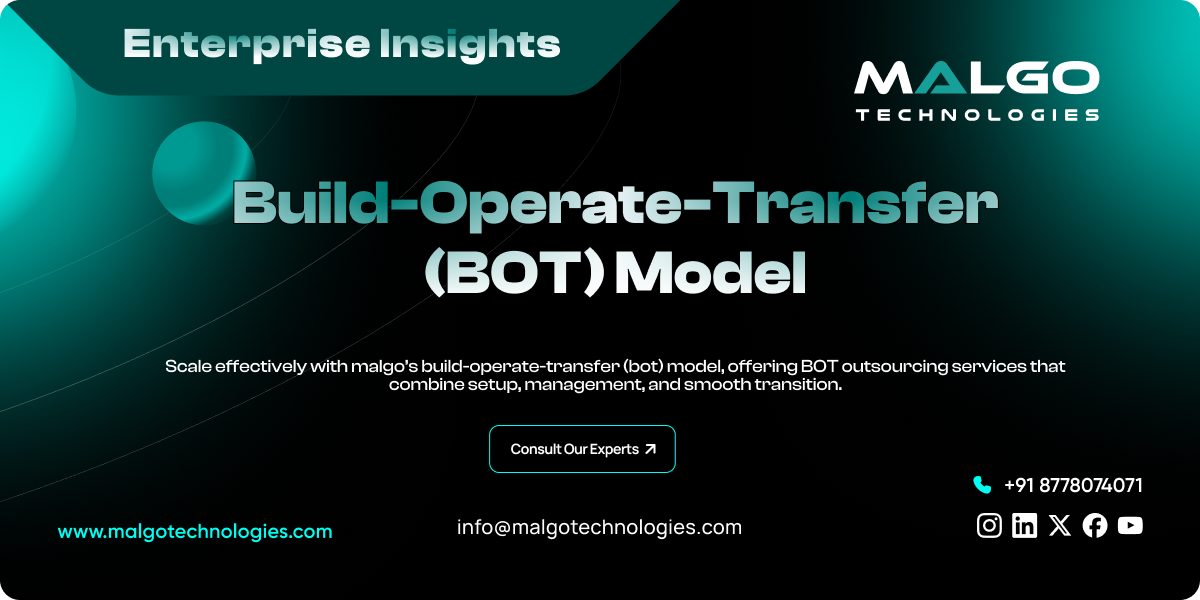What is Build-Transfer-Model?
The Build-Operate-Transfer (BOT) model is a strategic approach for businesses seeking to expand into new markets. It involves partnering with a specialized service provider to establish and manage a new business unit, often in a different country, before the client company takes full control of the operations. This model allows companies to access skilled talent and minimize risk without a large initial investment. It’s a flexible solution that combines the benefits of outsourcing with the long-term control of an in-house team. The BOT model is a popular choice for enterprise software development companies aiming for quick and efficient global growth.
This framework is particularly useful for companies in technology and other sectors that need a presence in new regions but lack the immediate resources or local expertise to do it alone. The service provider builds the infrastructure, hires the team, and manages daily operations, ensuring everything runs smoothly. After a pre-agreed period, the entire operation is handed over to the client. This structured process helps businesses overcome the typical challenges of international expansion, such as legal compliance, cultural differences, and resource management.
BOT Model in Business Operations Explained
The Build-Operate-Transfer model is a business strategy where a company hires a third-party service provider to create, run, and eventually hand over a complete business unit. This model is often used for setting up offshore development centers or remote offices. The service provider handles all the complexities of the initial setup, from legal registration to hiring staff and setting up the physical office. This allows the client company to focus on its core business activities while a dedicated team builds its presence in a new location.
Role of BOT Services in IT and Business Growth
BOT services play a key role in accelerating business growth, particularly in the IT sector. They provide a streamlined way to get a new team or office up and running quickly. By using a BOT service, a company can tap into new talent pools without the usual delays and difficulties. The service provider acts as a local expert, helping to find the right people and ensuring the new team integrates with the company’s goals. This process helps businesses scale their operations efficiently and enter new markets faster than they could on their own.
Main Benefits of the Build-Operate-Transfer Approach
The BOT approach offers several significant benefits for companies aiming for global expansion. It reduces the financial risk of entering a new market by shifting the initial investment and management burden to the service provider. It also provides access to specialized expertise and talent that may not be available locally. The model is also flexible, allowing companies to start with a small team and scale up as needed. The ultimate transfer of operations gives the client full control, ensuring long-term strategic alignment.
Stages in Build-Operate-Transfer (BOT) Services

The BOT process is divided into three distinct phases: Build, Operate, and Transfer. Each phase has specific goals and activities.
Build Phase – Infrastructure Setup and Team Formation
The Build Phase is the initial stage where the service provider sets up the entire operation from the ground up. This phase is crucial for laying a strong foundation for the future business unit. The provider takes on the responsibility of establishing all necessary components, from physical workspace to a fully staffed team.
- Infrastructure Setup: This involves securing and preparing office space, setting up all necessary IT systems, and establishing the legal and administrative frameworks. The service provider takes care of all local regulations and business registrations, ensuring the new unit is compliant from day one.
Team Formation: The service provider hires a dedicated team based on the client’s specific requirements. They handle the entire recruitment process, onboarding, and initial training to ensure the team has the necessary skills and is ready to work on the client's projects.
Operate Phase – Managing Daily Operations and Deliverables
Once the team and infrastructure are in place, the Operate Phase begins. During this stage, the service provider manages the daily operations, focusing on ensuring productivity and meeting project goals. The client can monitor progress and provide guidance, but the provider handles the day-to-day management.
- Project Management: The service provider manages the project teams, tracks progress, and ensures deliverables are met on time and to the required standards of quality. They implement project management tools and methodologies to maintain efficiency.
Human Resources and Administration: The service provider handles all HR-related tasks, including payroll, benefits, and performance reviews. They also manage the day-to-day administrative tasks, allowing the client to focus on strategic direction.
Transfer Phase – Shifting Operations to the Client
The Transfer Phase is the final stage where ownership of the business unit is handed over to the client. This transition is carefully planned to ensure a smooth change without disrupting ongoing work. The goal is to make the new team a seamless part of the client’s organization.
- Knowledge Transfer: The service provider trains the client’s designated staff and transfers all operational knowledge, documents, and intellectual property. This includes details about processes, technologies, and team dynamics.
Legal and Operational Handover: All legal entities, contracts, and operational responsibilities are formally transferred to the client. The client now has full control of the team and infrastructure, and the provider's role concludes.
Advantages of the BOT Model for Global Businesses
The BOT model provides distinct advantages for companies seeking to grow their global footprint. It helps them navigate the complexities of international expansion.
Cost Optimization and Efficient Resource Use
Using a BOT model can significantly reduce costs. The service provider already has local knowledge and established networks, which avoids the need for the client to spend time and money on market research and initial setup. This makes resources more efficient and predictable.
Skilled Talent Availability Across Markets
The BOT service provider can access a wider pool of skilled professionals in different global markets. This allows a company to find the best talent for their specific needs without being limited by its local hiring capabilities. The provider's expertise in local hiring practices is a major benefit.
Shared Responsibility for Risk Control
The BOT model shares the initial risks of market entry between the client and the service provider. The service provider handles the legal, logistical, and operational risks in the new location, which lowers the client’s exposure and provides a safer path to expansion.
Faster Market Entry with BOT Service Partnerships
By partnering with a BOT service provider, a company can enter a new market much more quickly. The provider’s existing infrastructure and expertise speed up the process, allowing the client to start operations faster and get ahead of competitors.
Build-Operate-Transfer (BOT) in IT Outsourcing Services
The BOT model is a powerful tool in IT outsourcing. It provides a structured path for businesses to build and manage remote technology teams that can eventually become part of the company.
BOT in Software Development Outsourcing
In software development, the BOT model allows a company to create a dedicated offshore team for software development. The service provider handles the recruitment of developers, testers, and project managers with the right skills. This team works exclusively on the client's projects, and after a set period, the client takes over the entire team and its management as an internal unit.
BOT in IT Infrastructure and Operational Support
For IT infrastructure, the BOT model can be used to set up and manage a remote support center or a network operations team. The service provider establishes the necessary IT systems and hires the staff to run the operations efficiently. Once the center is stable and running smoothly, the client can take full control.
BOT in Business Process Outsourcing (BPO)
In BPO, the BOT model can be used to set up a remote team for tasks like customer service, data entry, or finance. The service provider builds and operates the team, ensuring it meets performance metrics and service level agreements. The client can then absorb this team as an internal unit, gaining full control over their BPO functions and intellectual property.
Difference Between Traditional Outsourcing vs BOT Model Outsourcing
The table below highlights the key differences between traditional outsourcing and the BOT model.
Feature | Traditional Outsourcing | BOT Model Outsourcing |
Ownership | Service provider owns the resources and team. | Client eventually owns the resources and team. |
Control | Client has limited control over the team and operations. | Client has full control after the transfer phase. |
Risk | The client bears less risk, but may have less strategic alignment. | Initial risk is shared, but the client assumes full control and risk later. |
Strategic Goal | To get specific tasks done with a focus on cost savings. | To build a long-term, self-owned business unit in a new market. |
Exit Strategy | Can be ended with a contract termination. | Ends with a planned transfer of assets and team to the client. |
Key Challenges of Implementing the Build-Operate-Transfer Model in IT Outsourcing

While the BOT model offers many benefits, there are also challenges that need to be addressed for a successful implementation.
Overcoming Communication Barriers in BOT Outsourcing Projects
Communication can be a significant challenge, especially with teams in different time zones and cultures. Misunderstandings can lead to delays and errors.
- Clear Communication Protocols: It's important to establish clear communication channels and protocols from the start to ensure all parties are on the same page. This includes agreeing on communication tools and response times.
Regular Meetings: Regular meetings and status updates help keep projects on track and resolve any issues quickly. Video conferences can help build rapport and clarify intentions.
Selecting the Right Build-Operate-Transfer Service Provider
Choosing the right partner is crucial for a successful BOT project. A wrong choice can lead to significant problems and delays.
- Provider’s Experience: Look for a provider with a good track record in BOT services and a clear process for a smooth transition. They should be able to provide details on how they manage each phase.
Cultural Fit: It is important to choose a partner whose work culture and values align with your own. A shared work ethic and approach can prevent friction and improve collaboration.
Managing Reduced Control in IT Outsourcing with the BOT Model
During the build and operate phases, the client has less direct control over the daily activities of the team. This can be a concern for some companies.
- Performance Metrics: Establishing clear performance metrics and reporting systems can help the client monitor progress and ensure quality. Regular reports provide visibility into the team's performance.
Regular Audits: Conducting regular audits of the service provider’s operations can provide visibility and ensure compliance with the client’s standards and expectations.
Addressing Cultural Differences in Global IT Outsourcing
Cultural differences can impact how teams work and communicate, potentially affecting project outcomes and team cohesion.
- Cultural Training: Providing cultural training for both the client's and the service provider’s teams can help bridge communication and work style gaps. This helps build mutual respect and understanding.
Mutual Respect: A focus on mutual respect and open-mindedness helps build a strong working relationship, which is essential for a successful long-term partnership.
Long-Term Business Value of BOT Engagement Models
The BOT model provides long-term value that goes beyond the initial project and can become a foundation for future growth. It is a strategic investment in building a lasting asset for the company.
Scalability for Business Growth
The BOT model creates a scalable business unit. Once the team is transferred, the client can easily expand it as business needs grow without having to repeat the initial setup phase, as the groundwork has already been done. This allows for rapid and efficient scaling.
Flexibility for Expansion Strategies
This model provides flexibility for a company's expansion strategies. It allows businesses to test new markets or different operating models without committing to a full-scale investment from the start, which lowers the financial risk and allows for more agile decision-making.
Sustainability of the BOT Model in Outsourcing
The BOT model is a sustainable approach for long-term growth. It allows a company to build its own dedicated team and intellectual property in a new location, creating a lasting asset rather than just a temporary service. This provides a stable and reliable foundation for future operations.
Industries Applying BOT Services
The BOT model is used across various industries that require specialized teams and rapid expansion. Its flexibility makes it applicable to a wide range of sectors.
Technology and Software Development Companies
Technology and software development companies use BOT to set up offshore development centers to access a large pool of developers and accelerate product development cycles. This allows them to bring new products to market faster and maintain a competitive edge.
- They can quickly hire specialized teams for specific projects without a lengthy local recruitment process.
- The model helps them to build a dedicated research and development team in a location with a strong talent pool.
It allows for the creation of a permanent asset that is fully integrated into their company structure.
Financial Services and Fintech Businesses
Fintech firms use bots to build teams for software development, data analytics, and operational support to stay competitive and compliant in different markets. This helps them innovate while managing risk and regulatory requirements.
- They can establish a secure data processing center in a region with favorable regulations.
- The model helps in building a dedicated team for managing a new financial product or service.
It allows them to maintain a high level of control over sensitive data and intellectual property.
Telecom and Communication Providers
These companies use BOT to create remote operational centers for network management, customer support, and software development. This helps them expand their services and improve efficiency globally without significant upfront investment.
- The model allows them to set up a technical support center in a new country to serve local customers more effectively.
- They can build a dedicated team for network maintenance and monitoring in a strategic location.
It provides a way to gain local market insights and adapt services to regional needs.
Healthcare and Pharmaceutical Organizations
Healthcare companies use BOT to set up teams for data management, clinical research support, and IT infrastructure. This helps them manage large amounts of sensitive data and support their global operations efficiently and securely.
- The model helps them to build a team dedicated to managing clinical trial data in compliance with international standards.
- It allows for the creation of a secure IT support center for a network of hospitals or clinics.
They can establish a remote team for medical data analysis and reporting.
Why Choose Malgo as your Build Operate Transfer (BOT) Partner?
Malgo offers a structured approach to BOT services, providing a clear path for business expansion.
Structured BOT Engagement Process
Malgo provides a clear, step-by-step process for each phase of the BOT model, ensuring a smooth transition from build to transfer. This structured approach removes uncertainty and helps the client plan for the future with confidence.
- We provide a detailed roadmap for each phase of the project, from initial setup to final handover.
- The process includes regular progress reviews to ensure the project stays on track and meets client expectations.
We have a clear protocol for the final transfer, ensuring all legal and operational assets are correctly handed over.
Skilled Teams with Industry Knowledge
Malgo works with skilled professionals who have deep industry knowledge, ensuring the team we build for you is ready to meet your specific business needs. The team’s expertise is a key factor in the project's success, and Malgo prioritizes finding the right talent.
- We have access to a large network of skilled professionals in various markets.
- We handle the entire recruitment process, including screening and interviews, to find the best fit for your team.
The teams are trained on your company’s processes and tools before the final transfer.
Transparent Processes and Clear Reporting
Malgo maintains transparent communication and provides regular, clear reports on project progress and team performance. This keeps you informed and in control throughout the engagement, building a relationship based on trust and accountability.
- We provide access to a project management dashboard with real-time updates on key metrics.
- Regular reports detail team performance, project milestones, and any potential issues.
Open communication channels are maintained to ensure any questions or concerns are addressed promptly.
Global Service Delivery with Local Insights
Malgo has a global reach but also provides local market insights, which helps in setting up an operation that is both globally aligned and locally compliant. This combination of global reach and local knowledge is a significant advantage for international expansion.
- We provide guidance on local labor laws, regulations, and business practices.
- Our local teams have a deep understanding of the cultural nuances of the market.
We help in creating a team that can work seamlessly with your global operations while also adapting to local needs.
Final Insights on BOT Services
The Build-Operate-Transfer (BOT) model is more than just an outsourcing strategy; it is a business growth model. It provides a structured, low-risk way for companies to build a lasting presence in new markets. By handing over the initial setup and management to an expert provider, businesses can focus on their core competencies and achieve faster, more sustainable expansion. The BOT model is a strong solution for companies aiming for global scalability and long-term success.
Frequently Asked Questions
The BOT model reduces risks by shifting the initial burden of setup, legal compliance, and operations to an experienced partner. The client only takes full control once the business unit is stable, ensuring fewer risks related to local regulations, cultural misalignment, or resource mismanagement.
The BOT model is especially beneficial for IT companies, software development firms, fintech businesses, telecom providers, and healthcare organizations. Any enterprise looking to establish a long-term offshore or nearshore presence without the upfront hassle of infrastructure and hiring can gain from this approach.
The timeline varies depending on project scope, team size, and operational complexity. On average, BOT engagements last between 18 to 36 months before the transfer phase, giving the client enough time to assess stability and readiness for takeover.
While joint ventures involve shared ownership and profit distribution between two companies, the BOT model is structured for full client ownership after transfer. BOT provides more control and strategic independence once the handover is complete.
A structured knowledge transfer plan is critical. This includes proper documentation, staff training, system access handover, and detailed operational guidelines. Providers also align the offshore team with the client’s workflows to ensure continuity after transfer.


